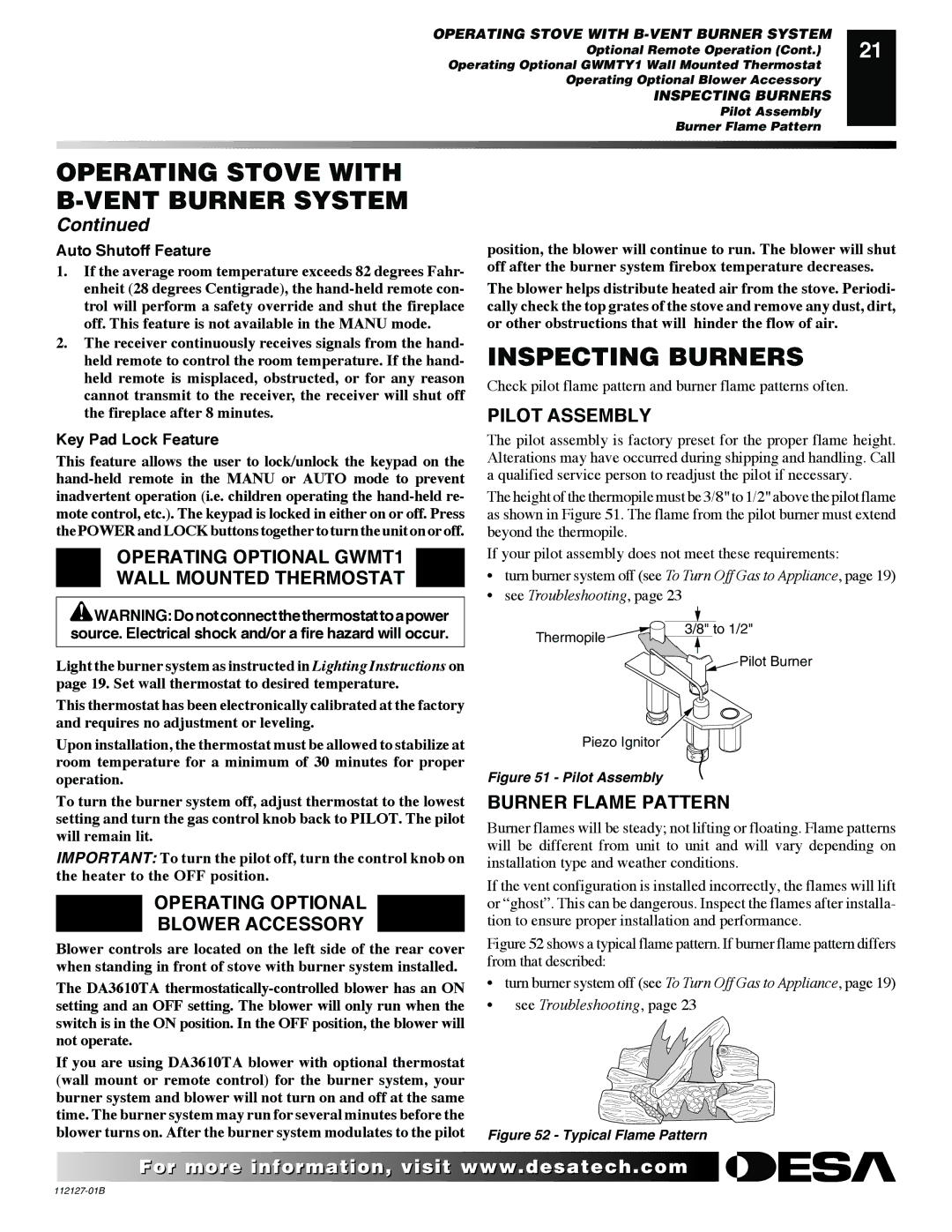
OPERATING STOVE WITH B-VENT BURNER SYSTEM
Optional Remote Operation (Cont.)
Operating Optional GWMTY1 Wall Mounted Thermostat
Operating Optional Blower Accessory
INSPECTING BURNERS
Pilot Assembly
Burner Flame Pattern
21
OPERATING STOVE WITH B-VENT BURNER SYSTEM
Continued
Auto Shutoff Feature
1.If the average room temperature exceeds 82 degrees Fahr- enheit (28 degrees Centigrade), the
2.The receiver continuously receives signals from the hand- held remote to control the room temperature. If the hand- held remote is misplaced, obstructed, or for any reason cannot transmit to the receiver, the receiver will shut off the fireplace after 8 minutes.
Key Pad Lock Feature
This feature allows the user to lock/unlock the keypad on the
OPERATING OPTIONAL GWMT1
WALL MOUNTED THERMOSTAT
![]() WARNING:Donotconnectthethermostattoapower source. Electrical shock and/or a fire hazard will occur.
WARNING:Donotconnectthethermostattoapower source. Electrical shock and/or a fire hazard will occur.
Light the burner system as instructed in Lighting Instructions on page 19. Set wall thermostat to desired temperature.
This thermostat has been electronically calibrated at the factory and requires no adjustment or leveling.
Upon installation, the thermostat must be allowed to stabilize at room temperature for a minimum of 30 minutes for proper operation.
To turn the burner system off, adjust thermostat to the lowest setting and turn the gas control knob back to PILOT. The pilot will remain lit.
IMPORTANT: To turn the pilot off, turn the control knob on the heater to the OFF position.
OPERATING OPTIONAL
BLOWER ACCESSORY
Blower controls are located on the left side of the rear cover when standing in front of stove with burner system installed.
The DA3610TA
If you are using DA3610TA blower with optional thermostat (wall mount or remote control) for the burner system, your burner system and blower will not turn on and off at the same time. The burner system may run for several minutes before the blower turns on. After the burner system modulates to the pilot
position, the blower will continue to run. The blower will shut off after the burner system firebox temperature decreases.
The blower helps distribute heated air from the stove. Periodi- cally check the top grates of the stove and remove any dust, dirt, or other obstructions that will hinder the flow of air.
INSPECTING BURNERS
Check pilot flame pattern and burner flame patterns often.
PILOT ASSEMBLY
The pilot assembly is factory preset for the proper flame height. Alterations may have occurred during shipping and handling. Call a qualified service person to readjust the pilot if necessary.
The height of the thermopile must be 3/8" to 1/2" above the pilot flame as shown in Figure 51. The flame from the pilot burner must extend beyond the thermopile.
If your pilot assembly does not meet these requirements:
•turn burner system off (see To Turn Off Gas to Appliance, page 19)
•see Troubleshooting, page 23
Thermopile | 3/8" to 1/2" |
|
![]()
![]() Pilot Burner
Pilot Burner
Piezo Ignitor
Figure 51 - Pilot Assembly
BURNER FLAME PATTERN
Burner flames will be steady; not lifting or floating. Flame patterns will be different from unit to unit and will vary depending on installation type and weather conditions.
If the vent configuration is installed incorrectly, the flames will lift or “ghost”. This can be dangerous. Inspect the flames after installa- tion to ensure proper installation and performance.
Figure 52 shows a typical flame pattern. If burner flame pattern differs from that described:
•turn burner system off (see To Turn Off Gas to Appliance, page 19)
•see Troubleshooting, page 23
Figure 52 - Typical Flame Pattern
For more![]()
![]()
![]()
![]() visit www.
visit www.![]()
![]()
![]() .com
.com![]()
![]()
![]()
![]()
![]()
